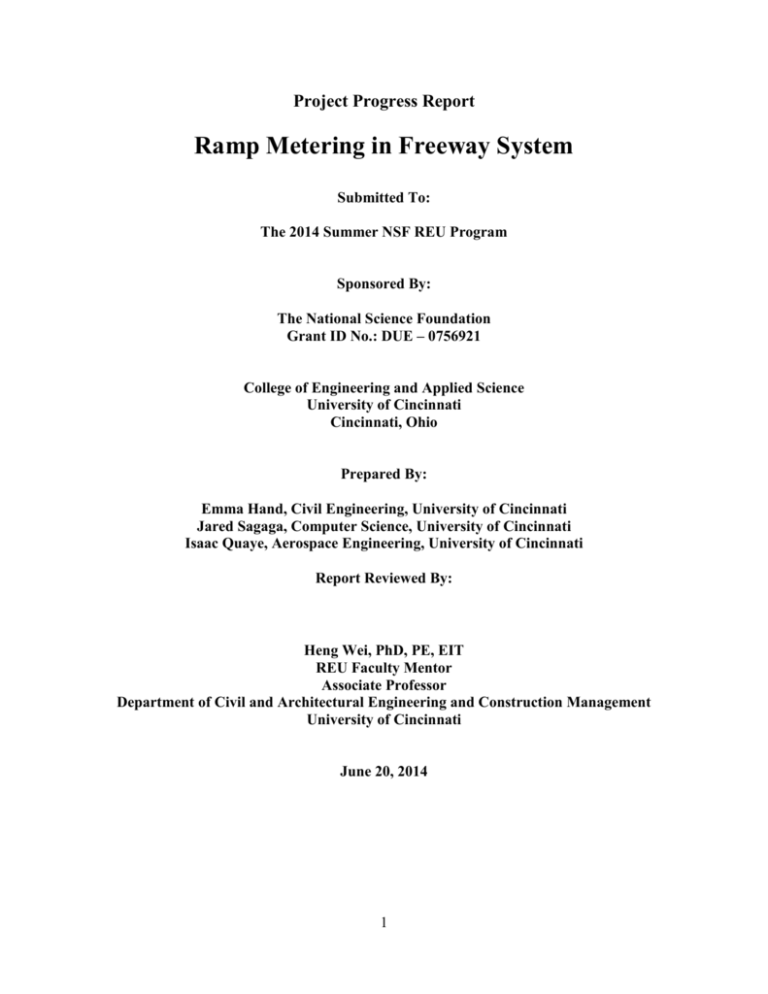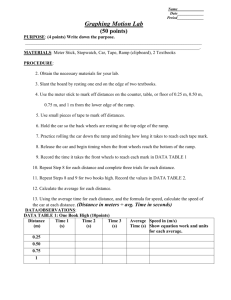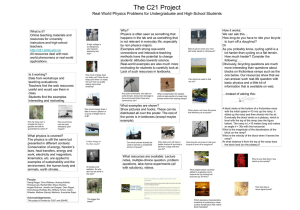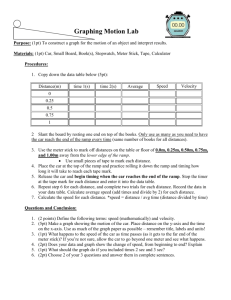Project Progress Report Ramp Metering in Freeway System
advertisement

Project Progress Report Ramp Metering in Freeway System Submitted To: The 2014 Summer NSF REU Program Sponsored By: The National Science Foundation Grant ID No.: DUE – 0756921 College of Engineering and Applied Science University of Cincinnati Cincinnati, Ohio Prepared By: Emma Hand, Civil Engineering, University of Cincinnati Jared Sagaga, Computer Science, University of Cincinnati Isaac Quaye, Aerospace Engineering, University of Cincinnati Report Reviewed By: Heng Wei, PhD, PE, EIT REU Faculty Mentor Associate Professor Department of Civil and Architectural Engineering and Construction Management University of Cincinnati June 20, 2014 1 Abstract In 2013, traffic congestion cost commuters in the U.S. approximately $101 billion in lost time and wasted fuel. Local governments and transportation agencies have used a variety of mitigation strategies to reduce the cost of traffic congestion. This report examines one such strategy, ramp metering. Using a modelling approach to evaluate the various types of metering, we will be taking into consideration various components such as operational characteristics, the ramp meter system in effect, and the amount of lanes on the on-ramp. The key element of deploying a ramp metering system is to control the traffic entering the freeway mainline, with the intent to reduce congestion and in turn reduce travel times and ensure the safety of motorists. Data collected during this project along with previously gathered data will be used to create traffic simulations using the micro simulation software VISSIM, and to determine the effectiveness of the placement of these meters. 2 Introduction Ramp metering systems are traffic devices used to control traffic entering the freeway mainline. Ramp meters are being used in states such as Arizona, Michigan, Minnesota and others, and have been shown to successfully regulate the flow of traffic on the freeway in order to reduce congestion, collisions and travel times to destinations. Different types of metering systems are used in differing situations, and each has its own benefits and drawbacks, including maintenance costs and ease of use. Ramp meters have been under development for decades, and have been proven in many cases to be successful, with benefits far outweighing any drawbacks. Departments of Transportation (DOT) in several states have performed tests which have proven the effectiveness of ramp meters, and have included the voice of the public in meter installation projects in order to gain the acceptance of residents and others who will be affected by the metering systems. While ramp meters have been proven to be successful, there are some limitations to these systems. They are very expensive to implement and maintain, and complicated algorithms are used that will render ramp meters ineffective if there are any errors. Isolated ramp meters fail to detect upstream or downstream traffic flows, which can result in serious traffic congestions when there is sudden traffic change. Regardless of these limitations, ramp meter strategies are expanding nationwide. Background Literature Review Ramp Meters in Different States Several states around the country use ramp metering to control traffic, increase freeway safety, reduce travel time and maximize freeway throughput. 3 Some of these states include Minnesota (433 ramp meters), Arizona (300 ramp meters), California (1,000 ramp meters), and Washington (280 ramp meters) (Minnesota Dept. of Transportation; Arizona Dept. of Transportation; California Dept. of Transportation; Jacobson, Stribiak, Nelson, Sallman). The types of ramp meters used vary from state to state. In Minnesota, depending on the ramp and traffic conditions, either fixed time or responsive ramp meters are installed, and are monitored throughout the entire state in a single system containing many sub-systems (Jacobson, Stribiak, Nelson, Sallman). In Washington, responsive traffic meters and fuzzy logic are used to run the ramp metering system statewide (Jacobson, Stribiak, Nelson, Sallman). The introduction of ramp metering to Minnesota and Washington brought about several benefits, but also presented each state with some difficulties during the implementation of the metering systems. Some of the difficulties that were faced by each state’s Department of Transportation about ramp metering include: Poor performance in inclement weather or during special events Vehicle queues force overrides causing the algorithms to restart Staffing, training, and ramp metering implementation Complete acceptance by the public Poor marketing of its benefits and high reciprocity at a low expense The Departments of Transportation in Minnesota (Mn/DOT) and Washington (WSDOT) are still facing these issues today (U.S. Dept. of Transportation). With technology improving every day, however, the difficulties are not as severe as when ramp metering 4 was first introduced onto these states’ freeways. These difficulties can also cause decisions on ramp metering installation to take some time, especially if public input is needed to make the decisions. Washington includes the public in its ramp metering program, with public outreach and disseminating information being vital to any planning of ramp metering installation (Jacobson, Stribiak, Nelson, Sallman). Minnesota has also implemented this type of method into their future plans for proposed ramp metering installations after performing an evaluation in 2001 on their ramp metering system in Twin Cities. Uses of Ramp Metering According to the FHWA (Federal Highway Administration), - Ramp meters are used to regulate and reduce traffic volume on freeways by spreading out queues of vehicles over a period of time. - Reduced traffic congestions are a result of traffic meters, increasing freeway speeds and thereby improving travel time and travel time reliability. - Metering systems help lessen crashes on freeways around the entrance ramps, in effect ensuring the increased safety of motorists. Types of Ramp Metering There are different types of ramp metering systems that are put in place, each with its own benefits and limitations. 5 Fixed Ramp Metering Fixed Ramp Meter systems, also called Pre-timed Ramp Meter systems, operate on a fixed ramp cycle, or period of time that the meter goes through the colors red and green. This pre-timed meter cycle is based off of data from past traffic conditions, assuming the patterns of these conditions are fairly constant from day to day (Kang). Different meter cycles are used depending on how many cars are intended to pass through. A system designed to break up platoons, or large groups of vehicles, has a cycle between four to seven seconds, with meter rates lasting just long enough for one or two cars to pass through at a time. During times of the day when traffic is not expected to be as busy, cycles last ten seconds or more allowing three or more vehicles to pass at a time. In the present study, the cycle used for the single lane on ramp will be four seconds and the cycle for the two lane ramp will be 6.56 seconds. Benefits Fixed ramp meter systems have low maintenance costs, and provide drivers with a reliable pattern to which they can easily adjust (Kang). The pre-timed systems provide benefits associated with reduced congestion. Travel time and side-swipe accidents that happen when incoming traffic merges onto the mainline freeway are lessened, while throughput, or the lack of traffic stand-stills, is increased. Limitations Fixed meter cycles do not respond to any traffic conditions on the freeway mainline, remaining unaltered even if there are sudden fluctuations in the traffic. There can also be 6 a problem with fixed meter systems when the amount of vehicles on the on-ramp reaches capacity, because traffic enters the on-ramp at a greater rate than the meter allows traffic to access the freeway. Traffic Responsive Ramp Metering The meter cycles of responsive ramp meters are based on real-time measurements from sensors installed along the freeway network shown in Fig. 1. The mainline loops give the occupancy of the mainline traffic. The passage loop gives the count of vehicles that pass through the meter. The demand loops relay to the meter when there are vehicles waiting to enter the freeway; when these sense no vehicles, the meter remains red. The queue loop senses how many vehicles enter the on-ramp and whether it is full. All of these factors contribute to the meter’s determining of the meter rate. These meter systems can be either local or coordinated. The local ramp metering method uses measurements from an area around a single ramp whereas the coordinated ramp metering system uses data from the entire network. Sites have differing traffic conditions, and based on these conditions an apt algorithm is used. Depending on the algorithm used, coordinated responsive systems either sense only traffic from local arterials, streets by the highway, or communicate with meter systems on adjacent ramps. (Papamichail I., and Papageorgiou, M.) 7 Figure 1. Responsive ramp metering system diagram Benefits The local and coordinated ramp metering strategies have proven to be more efficient than the fixed traffic ramp meters because of the sensors that communicate between the freeway and the ramp meters. There are no backups onto local arterials due to the sensor at the entrance to the on-ramp. Sensors detecting the current traffic conditions on the mainline freeway allow the meter to change its rates accordingly. The traffic responsive strategy is a better regulator of traffic from the ramp joining the freeway. 8 Limitations Coordinated ramp meter systems are extremely complex, and thus very expensive to install and maintain. Isolated systems do not take into account the traffic upstream or downstream of the on-ramp. This can cause problems if sudden traffic changes occur further out than the isolated system senses, and the ramp meter allows too much traffic to enter the freeway. (Papamichail I., and Papageorgiou, M.) Goals and Objectives The objectives of this project are to investigate and understand the effectiveness of ramp metering placements, and determine the number of installments needed on a stretch of highway. The effects of single and two lane ramp metering implementation will be observed, through data collected from I-275 and US-42 Lebanon Road during peak periods, simulations created by the group in VISSIM, and information gathered from several other sources. Scope of Study The main focus of this research will be on the traffic conditions at a single lane on-ramp without a ramp meter, and both single and two lane on-ramps with ramp meters. The selection of the sites should meet the following criteria: 1) There are elevated locations nearby for placing the camcorder to capture the traffic. 2) Location should be busier in the peak hours than the normal flow of freeway. 9 Based on the above criteria, the I-275 and US- 42 Lebanon road intersection is the chosen study site selected for the current research. Video data will be collected and postprocessed using a traffic counter, and a GPS device will be utilized while driving on a given stretch of the road during peak hours of the day. Traffic flow on the freeway mainline, on-ramp, and arterials will be observed, and both a single and two lane ramp implementation will be investigated. Information gained from the observations of these on-ramps will be analyzed in order to determine which type of ramp metering is most effective and efficient. The gathered data will be used to create simulations of possible real-world scenarios in VISSIM. The simulations will also aid in the investigation of future implementation of ramp metering. 10 References Arnold, Jr., E. D. (1998). “Ramp Metering: A Review of the Literature,” Technical Assistance Report No. VTRC 99-TAR5, Virginia Transportation Research Council, Charlottesville, Virginia. Department of Transportation, California (2007). "Why Are There Signals Installed at Some Freeway Onramps?" Why Are There Signals Installed at Some Freeway Onramps? Web. 16 June 2014. Department of Transportation, Minnesota (2011). "Ramp Meters." Minnesota Department of Transportation. Web. 16 June 2014. DeWelles, Angela (2011). "ADOT Blog: Getting the Green Light: Valley Ramp Meters Now More Efficient." ADOT Blog: Getting the Green Light: Valley Ramp Meters Now More Efficient. Web. 16 June 2014. Federal Highway Administration (2013). "Ramp Metering Presentation." Localized Bottleneck Reduction Program. US Department of Transportation. Web. 16 June 2014. Jacobson, Leslie N., Jason Stribiak, Lisa Nelson, and Doug Sallman (2006). "Chapter 11 - Case Studies." Ramp Management and Control Handbook. Washington, DC: U.S. Dept. of Transportation, Federal Highway Administration. 11-2-11-29. Print. Kang, S., Gillen, D. (1999). “Assessing the Benefits and Costs of Intelligent Transportation Systems: Ramp Meters,” California PATH Research Report No. UCB-ITS-PRR99-19, Institution of Transportation Studies, University of California, Berkley, California. Arizona Department of Transportation. (2003). Ramp Meter Design, Operations, and Maintenance Guidelines. Papamichail I., and Papageorgiou, M. (2008). “Traffic-Responsive Linked Ramp-Metering Control,” IEEE Transactions on Intelligent Transportation Systems, Vol. 9, No. 1, n.p. State of California Department of Transportation. “Ramp Metering In Caltrans District 7 (Los Angeles and Ventura Counties).” 2005. Yu, G., Recker, W., Chu, L. (2009). “Integrated Ramp Metering Design and Evaluation Platform with Paramics,” California PATH Research Report No. UCB-ITS-PRR-2009-10, Institution of Transportation Studies, University of California, Berkley, California. Zongzhong, T., Nadeem, A. C., Messer, C. J., Chu, C. (2004). “Ramp Metering Algorithms and Approaches for Texas,” Transportation Technical Report No. FHWA/TX-05/0-4629-1, Texas Transportation Institute, The Texas A&M University System, College Station, Texas. 11






